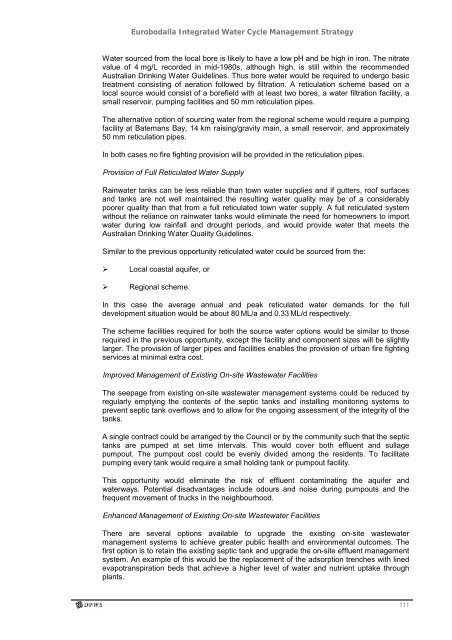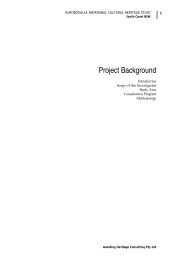Eurobodalla Integrated Water Cycle Management Strategy
Eurobodalla Integrated Water Cycle Management Strategy
Eurobodalla Integrated Water Cycle Management Strategy
Create successful ePaper yourself
Turn your PDF publications into a flip-book with our unique Google optimized e-Paper software.
<strong>Eurobodalla</strong> <strong>Integrated</strong> <strong>Water</strong> <strong>Cycle</strong> <strong>Management</strong> <strong>Strategy</strong><br />
<strong>Water</strong> sourced from the local bore is likely to have a low pH and be high in iron. The nitrate<br />
value of 4 mg/L recorded in mid-1980s, although high, is still within the recommended<br />
Australian Drinking <strong>Water</strong> Guidelines. Thus bore water would be required to undergo basic<br />
treatment consisting of aeration followed by filtration. A reticulation scheme based on a<br />
local source would consist of a borefield with at least two bores, a water filtration facility, a<br />
small reservoir, pumping facilities and 50 mm reticulation pipes.<br />
The alternative option of sourcing water from the regional scheme would require a pumping<br />
facility at Batemans Bay, 14 km raising/gravity main, a small reservoir, and approximately<br />
50 mm reticulation pipes.<br />
In both cases no fire fighting provision will be provided in the reticulation pipes.<br />
Provision of Full Reticulated <strong>Water</strong> Supply<br />
Rainwater tanks can be less reliable than town water supplies and if gutters, roof surfaces<br />
and tanks are not well maintained the resulting water quality may be of a considerably<br />
poorer quality than that from a full reticulated town water supply. A full reticulated system<br />
without the reliance on rainwater tanks would eliminate the need for homeowners to import<br />
water during low rainfall and drought periods, and would provide water that meets the<br />
Australian Drinking <strong>Water</strong> Quality Guidelines.<br />
Similar to the previous opportunity reticulated water could be sourced from the:<br />
Local coastal aquifer, or<br />
Regional scheme.<br />
In this case the average annual and peak reticulated water demands for the full<br />
development situation would be about 80 ML/a and 0.33 ML/d respectively.<br />
The scheme facilities required for both the source water options would be similar to those<br />
required in the previous opportunity, except the facility and component sizes will be slightly<br />
larger. The provision of larger pipes and facilities enables the provision of urban fire fighting<br />
services at minimal extra cost.<br />
Improved <strong>Management</strong> of Existing On-site Wastewater Facilities<br />
The seepage from existing on-site wastewater management systems could be reduced by<br />
regularly emptying the contents of the septic tanks and installing monitoring systems to<br />
prevent septic tank overflows and to allow for the ongoing assessment of the integrity of the<br />
tanks.<br />
A single contract could be arranged by the Council or by the community such that the septic<br />
tanks are pumped at set time intervals. This would cover both effluent and sullage<br />
pumpout. The pumpout cost could be evenly divided among the residents. To facilitate<br />
pumping every tank would require a small holding tank or pumpout facility.<br />
This opportunity would eliminate the risk of effluent contaminating the aquifer and<br />
waterways. Potential disadvantages include odours and noise during pumpouts and the<br />
frequent movement of trucks in the neighbourhood.<br />
Enhanced <strong>Management</strong> of Existing On-site Wastewater Facilities<br />
There are several options available to upgrade the existing on-site wastewater<br />
management systems to achieve greater public health and environmental outcomes. The<br />
first option is to retain the existing septic tank and upgrade the on-site effluent management<br />
system. An example of this would be the replacement of the adsorption trenches with lined<br />
evapotranspiration beds that achieve a higher level of water and nutrient uptake through<br />
plants.<br />
111

















